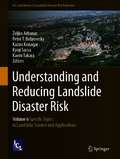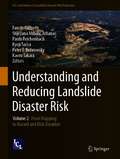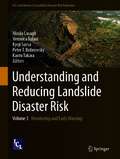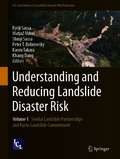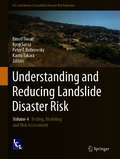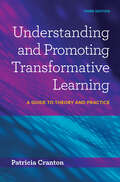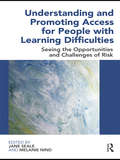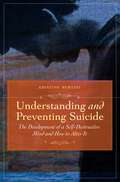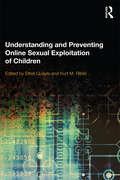- Table View
- List View
Understanding and Reducing Prison Violence: An Integrated Social Control-Opportunity Perspective (Routledge Frontiers of Criminal Justice)
by Benjamin Steiner John WooldredgeUnderstanding and Reducing Prison Violence considers both the individual and prison characteristics associated with violence perpetration and violent victimization among both prison inmates and staff. Prison violence is not a random process; rates of violence vary across prisons and the odds of perpetrating violence or experiencing violent victimization vary across inmates and staff. A comprehensive understanding of the causes of prison violence therefore requires consideration of both individual and prison characteristics. Building on large dataset comprising 5,500 inmates and 1,800 officers across 45 prisons located across two of the United States (Ohio and Kentucky), this book showcases one of the largest and most comprehensive studies of prisons carried out to date. It considers both the implications of the study for theories of prison violence and the implications of the study for preventing violence in prisons. It will be of interest to academics, practitioners, and policy makers alike.
Understanding and Reducing Landslide Disaster Risk: Volume 6 Specific Topics in Landslide Science and Applications (ICL Contribution to Landslide Disaster Risk Reduction)
by Peter T. Bobrowsky Kyoji Sassa Željko Arbanas Kaoru Takara Kazuo KonagaiThis book is a part of ICL new book series “ICL Contribution to Landslide Disaster Risk Reduction” founded in 2019. Peer-reviewed papers submitted to the Fifth World Landslide Forum were published in six volumes of this book series. This book contains the following parts:• Impact of Large Ground Deformations near Seismic Faults on Critically Important Civil Infrastructures• Recent Progress in the Landslide Initiating Science• Earth Observation and Machine Learning in Landslide Science• General Landslide StudiesProfessor Željko Arbanas is the Vice President of International Consortium on Landslides. He is a Professor of Faculty of Civil Engineering, University of Rijeka, Croatia. He is the Assistant Editor-in-Chief of International Journal Landslides.Professor Peter Bobrowsky is the President of International Consortium on Landslides. He is a Senior Scientist of Geological Survey of Canada, Ottawa, Canada.Professor Kazuo Konagai is Professor Emeritus at the University of Tokyo and Principal Researcher at the ICL Headquarters. He serves as the Secretary-General of the Fifth World Landslide Forum.Professor Kyoji Sassa is the Founding President and the Secretary-General of the International Consortium on Landslides (ICL). He has been the Editor-in-Chief of International Journal Landslides since its foundation in 2004.Professor Kaoru Takara is the Executive Director of International Consortium on Landslides. He is a Professor and Dean of Graduate School of Advanced Integrated Studies (GSAIS) in Human Survivability (Shishu-Kan), Kyoto University.
Understanding and Reducing Landslide Disaster Risk: Volume 2 From Mapping to Hazard and Risk Zonation (ICL Contribution to Landslide Disaster Risk Reduction)
by Peter T. Bobrowsky Kyoji Sassa Fausto Guzzetti Kaoru Takara Snježana Mihalić Arbanas Paola ReichenbachThis book is a part of ICL new book series “ICL Contribution to Landslide Disaster Risk Reduction” founded in 2019. Peer-reviewed papers submitted to the Fifth World Landslide Forum were published in six volumes of this book series. This book contains the followings:• Keynotes• Landslide detection, recognition and mapping• Landslide susceptibility assessment and modelling• Landslide size statistics and temporal modelling• Data and information for landslide disaster mitigation• Vulnerability to landslides of people, communities and the built environmentDr. Fausto Guzzetti is General Director of Office III – Technical and Scientific Activities for Risk Forecasting and Prevention, Department of Civil Protection, Italian Presidency of the Council of Ministers, on leave from the Italian National Research Council.Prof. Snježana Mihalić Arbanas is a Full Professor of the Faculty of Mining, Geology and Petroleum Engineering of the University of Zagreb, Croatia. She is the Chair of ICL Network Committee.Paola Reichenbach is a Senior Researcher of the Research Institute for Geo-Hydrological Protection, an institute of the Italian National Research Council (IRPI-CNR), Perugia, Italy.Prof. Kyoji Sassa is the Founding President and the Secretary-General of the International Consortium on Landslides (ICL). He has been the Editor-in-Chief of International Journal Landslides since its foundation in 2004.Prof. Peter Bobrowsky is the President of the International Consortium on Landslides. He is a Senior Scientist of Geological Survey of Canada, Ottawa, Canada.Prof. Kaoru Takara is the Executive Director of the International Consortium on Landslides. He is a Professor and Dean of Graduate School of Advanced Integrated Studies (GSAIS) in Human Survivability (Shishu-Kan), Kyoto University.
Understanding and Reducing Landslide Disaster Risk: Volume 3 Monitoring and Early Warning (ICL Contribution to Landslide Disaster Risk Reduction)
by Nicola Casagli Veronica Tofani Kyoji Sassa Peter T. Bobrowsky Kaoru TakaraThis book is a part of ICL new book series “ICL Contribution to Landslide Disaster Risk Reduction” founded in 2019. Peer-reviewed papers submitted to the Fifth World Landslide Forum were published in six volumes of this book series. This book contains the followings:• One theme lecture and one keynote lecture• Monitoring and remote sensing for landslide risk mitigation, including one keynote lecture• Landslide early warning systems, forecasting models and time prediction of landslidesProf. Nicola Casagli is a Vice President and President-elect of the International Consortium on Landslides (ICL) for 2021–2023. He is Professor of engineering geology at the Department of Earth Sciences, University of Florence, and President of the National Institute of Oceanography and Applied Geophysics – OGS, Trieste, Italy.Dr. Veronica Tofani is an Associate Professor at the Department of Earth Sciences, University of Florence, and Program Coordinator of the UNESCO Chair on Prevention and Sustainable Management of Geo-hydrological hazards, University of Florence.Prof. Kyoji Sassa is the Founding President and the Secretary-General of the International Consortium on Landslides (ICL). He has been the Editor-in-Chief of International Journal Landslides since its foundation in 2004.Prof. Peter Bobrowsky is the President of the International Consortium on Landslides. He is a Senior Scientist of Geological Survey of Canada, Ottawa, Canada.Prof. Kaoru Takara is the Executive Director of the International Consortium on Landslides. He is a Professor and Dean of Graduate School of Advanced Integrated Studies (GSAIS) in Human Survivability (Shishu-Kan), Kyoto University.
Understanding and Reducing Landslide Disaster Risk: Volume 1 Sendai Landslide Partnerships and Kyoto Landslide Commitment (ICL Contribution to Landslide Disaster Risk Reduction)
by Kyoji Sassa Matjaž Mikoš Shinji Sassa Peter T. Bobrowsky Kaoru Takara Khang DangThis book is a part of ICL new book series “ICL Contribution to Landslide Disaster Risk Reduction” founded in 2019. Peer-reviewed papers submitted to the Fifth World Landslide Forum were published in six volumes of this book series. This book contains the followings:• Four Forum lectures and one award paper• Sendai Landslide Partnerships, Kyoto Landslide Commitment, and International Programme on Landslides.• Landslide-induced tsunamis• Landslides at UNESCO designates sites and contribution from WMO, FAO, and IRDR• Education and Capacity Development for Risk Management and Risk GovernanceProf. Kyoji Sassa is the Founding President and the Secretary-General of International Consortium on Landslides (ICL). He has been the Editor-in-Chief of International Journal Landslides since its foundation in 2004.Prof. Matjaž Mikoš is the Vice President of International Consortium on Landslides and Vice President of Slovenian Academy of Engineering. He is a Professor and Dean of Faculty of Civil and Geodetic Engineering, University of Ljubljana, Slovenia.Dr. Shinji Sassa is Head of Soil Dynamics Group and Research Director of International Research Center for Coastal Disasters, Port and Airport Research Institute, National Institute of Maritime, Port and Aviation Technology, Japan.Prof. Peter Bobrowsky is the President of International Consortium on Landslides. He is a Senior Scientist of Geological Survey of Canada, Ottawa, Canada.Prof. Kaoru Takara is the Executive Director of International Consortium on Landslides. He is a Professor and Dean of Graduate School of Advanced Integrated Studies (GSAIS) in Human Survivability (Shishu-Kan), Kyoto University.Dr. Khang Dang is the Secretary General of the Fifth World Landslide Forum. He also serves as the Research Promotion Officer of ICL and a Lecturer at the University of Science, Vietnam National University, Hanoi.
Understanding and Reducing Landslide Disaster Risk: Volume 4 Testing, Modeling and Risk Assessment (ICL Contribution to Landslide Disaster Risk Reduction)
by Binod Tiwari Kyoji Sassa Peter T. Bobrowsky Kaoru TakaraThis book is a part of ICL new book series “ICL Contribution to Landslide Disaster Risk Reduction” founded in 2019. Peer-reviewed papers submitted to the Fifth World Landslide Forum were published in six volumes of this book series. This book contains the followings:• Five keynote lectures• Recent development in physical modeling of landslides• Recent development in numerical modeling of landslides• Recent development in soil and rock testing techniques, application and analysis methods• Recent advancements in the methods of slope stability and deformation analyses• Recent development in disaster risk assessmentProf. Binod Tiwari is a Vice President of the International Consortium on Landslides (ICL). He is the Associate Vice President for research and sponsored project and Professor of civil and environmental engineering at the California State University, Fullerton, California, USA.Prof. Kyoji Sassa is the Founding President and the Secretary-General of the International Consortium on Landslides (ICL). He has been the Editor-in-Chief of International Journal Landslides since its foundation in 2004.Prof. Peter Bobrowsky is the President of the International Consortium on Landslides. He is a Senior Scientist of Geological Survey of Canada, Ottawa, Canada.Prof. Kaoru Takara is the Executive Director of the International Consortium on Landslides. He is a Professor and Dean of Graduate School of Advanced Integrated Studies (GSAIS) in Human Survivability (Shishu-Kan), Kyoto University.
Understanding and Reducing Landslide Disaster Risk: Volume 5 Catastrophic Landslides and Frontiers of Landslide Science (ICL Contribution to Landslide Disaster Risk Reduction)
by Vít Vilímek Fawu Wang Alexander Strom Kyoji Sassa Peter T. Bobrowsky Kaoru TakaraThis book is a part of ICL new book series “ICL Contribution to Landslide Disaster Risk Reduction” founded in 2019. Peer-reviewed papers submitted to the Fifth World Landslide Forum were published in six volumes of this book series. This book contains the followings:Part I with topics is mainly about landslides and earthquakes; landslide dams and outburst floods; catastrophic large-scale landslides in mountainous regions.Part II with topics is mainly about impact of climate change; loess landslides; mapping, monitoring and modeling of landslides; stabilization and mitigation; application of new technology in landslide studies.Prof. Vít Vilímek is the vice-president of the International Consortium on Landslides (ICL) and a member of the evaluation committee, Editor-in-Chief of the university journal AUC Geographica and Associate Editor-in-Chief of the international journal Geoenvironmental Disasters. He is a Professor of Physical Geography at Charles University, Prague, Czech Republic.Prof. Fawu Wang is the President of the International Consortium on Geo-disaster Reduction (ICGdR) and the Editor-in-Chief of the international journal Geoenvironmental Disasters. He is a Professor at the School of Civil Engineering, Tongji University, China.Dr. Alexander Strom is a chief expert at the Geodynamics Research Center LLC, Moscow, Russia. He is also an Adjunct Professor at Chang’an University, Xi’an, China, Visiting Professor at SKLGP, Chengdu, China, and an alternative representative of the JSC “Hydroproject Institute” in ICL.Prof. Kyoji Sassa is the Founding President and the Secretary-General of the International Consortium on Landslides (ICL). He has been the Editor-in-Chief of International Journal Landslides since its foundation in 2004.Prof. Peter Bobrowsky is the President of the International Consortium on Landslides. He is a Senior Scientist of Geological Survey of Canada, Ottawa, Canada.Prof. Kaoru Takara is the Executive Director of the International Consortium on Landslides. He is a Professor and Dean of Graduate School of Advanced Integrated Studies (GSAIS) in Human Survivability (Shishu-Kan), Kyoto University.
Understanding and Recognizing Dysfunctional Leadership: The Impact of Dysfunctional Leadership on Organizations and Followers
by Annette B. RoterSince the early twentieth century, scholars have researched leadership and it is one of the most researched topics of our time. Understanding how to be a strong leader and what makes a good leader is something that we continue to strive to understand. Research ponders various positive leadership models such as transformational, servant, authentic, charismatic, situational and ethical leadership to name a few. Yet, we find that a small number of our leaders are truly transformational. While scholars continue to provide examples of positive and influential leaders, we still struggle to understand what a dysfunctional leader is. Practitioners and followers are quick to identify a leader that is a nightmare, yet they can’t name what type of dysfunction that leader possesses. Day in and day out, we struggle with these leaders and how to intervene when dysfunctional behavior arises. This is most evident with recent scandals that have plagued the media involving characters such as Bernie Madoff, Dennis Kozlowski, Tyco, Enron’s Kenneth Lay and Jeff Skilling. It is vital to understand the importance of dysfunctional leadership and its impact on organizations, followers and society. The recent literature focuses on the psychology of dysfunctional leadership and the destruction of organizations. Little has been written in relation to the characteristics, traits and behaviors of dysfunctional leaders. In addition, little has been included on how to deal with this types of behavior within organizations. Individual books have been written on each of these types of characteristics, but no one book has been written that focuses on all of these characteristics and studies the subtle differences of these behaviors, interventions that can be employed to address this type of behavior and how to recognize the impact on our organizations. Understanding and Recognizing Dysfunctional Leadership will be of interest to professionals and researchers in this field.
Understanding and Recognizing Dysfunctional Leadership: The Impact of Dysfunctional Leadership on Organizations and Followers
by Annette B. RoterSince the early twentieth century, scholars have researched leadership and it is one of the most researched topics of our time. Understanding how to be a strong leader and what makes a good leader is something that we continue to strive to understand. Research ponders various positive leadership models such as transformational, servant, authentic, charismatic, situational and ethical leadership to name a few. Yet, we find that a small number of our leaders are truly transformational. While scholars continue to provide examples of positive and influential leaders, we still struggle to understand what a dysfunctional leader is. Practitioners and followers are quick to identify a leader that is a nightmare, yet they can’t name what type of dysfunction that leader possesses. Day in and day out, we struggle with these leaders and how to intervene when dysfunctional behavior arises. This is most evident with recent scandals that have plagued the media involving characters such as Bernie Madoff, Dennis Kozlowski, Tyco, Enron’s Kenneth Lay and Jeff Skilling. It is vital to understand the importance of dysfunctional leadership and its impact on organizations, followers and society. The recent literature focuses on the psychology of dysfunctional leadership and the destruction of organizations. Little has been written in relation to the characteristics, traits and behaviors of dysfunctional leaders. In addition, little has been included on how to deal with this types of behavior within organizations. Individual books have been written on each of these types of characteristics, but no one book has been written that focuses on all of these characteristics and studies the subtle differences of these behaviors, interventions that can be employed to address this type of behavior and how to recognize the impact on our organizations. Understanding and Recognizing Dysfunctional Leadership will be of interest to professionals and researchers in this field.
Understanding and Promoting Transformative Learning: A Guide to Theory and Practice
by Patricia CrantonThe third edition of Patricia Cranton’s Understanding and Promoting Transformative Learning brings a wealth of new insight from the tremendous growth in the field during the decade since the previous edition. As in the previous editions, the book helps adult educators understand what transformative learning is, distinguish it from other forms of learning, and foster it in their practice. The first part of the book is dedicated to clarifying transformative learning theory and relating it to other theoretical frameworks. The author examines transformative learning from the learner’s perspective, and discusses individual differences in how learners go through the process. In the second half of the book, the focus is squarely on strategies for promoting transformative learning in a wide variety of adult and higher education contexts. Practitioners will be able to take ideas from the text and apply them directly in their teaching.Since 1975, transformative learning has become a core theoretical perspective in adult and higher education, and research has proliferated. In the past decade, adult education and especially transformative learning grew into a noticeably larger field. The numbers of undergraduate and graduate programs in adult education have increased and continue to increase as more and more individuals are seeking the expertise, skills, and training necessary to work with adult learners in higher education, business, industry, government, health professions, non-profit organizations, and community development. In addition, the number of programs in higher education (both undergraduate and graduate) that include courses in transformative learning has grown dramatically. These academic audiences use the book to further their understanding of transformative learning theory and practice.Drawing on the latest research as well as the author’s own teaching experience in both online and face-to-face courses, this new edition will be a vital resource for members of the transformative learning community, as well as those encountering the topic for the first time.
Understanding and Promoting Transformative Learning: A Guide to Theory and Practice
by Patricia CrantonThe third edition of Patricia Cranton’s Understanding and Promoting Transformative Learning brings a wealth of new insight from the tremendous growth in the field during the decade since the previous edition. As in the previous editions, the book helps adult educators understand what transformative learning is, distinguish it from other forms of learning, and foster it in their practice. The first part of the book is dedicated to clarifying transformative learning theory and relating it to other theoretical frameworks. The author examines transformative learning from the learner’s perspective, and discusses individual differences in how learners go through the process. In the second half of the book, the focus is squarely on strategies for promoting transformative learning in a wide variety of adult and higher education contexts. Practitioners will be able to take ideas from the text and apply them directly in their teaching.Since 1975, transformative learning has become a core theoretical perspective in adult and higher education, and research has proliferated. In the past decade, adult education and especially transformative learning grew into a noticeably larger field. The numbers of undergraduate and graduate programs in adult education have increased and continue to increase as more and more individuals are seeking the expertise, skills, and training necessary to work with adult learners in higher education, business, industry, government, health professions, non-profit organizations, and community development. In addition, the number of programs in higher education (both undergraduate and graduate) that include courses in transformative learning has grown dramatically. These academic audiences use the book to further their understanding of transformative learning theory and practice.Drawing on the latest research as well as the author’s own teaching experience in both online and face-to-face courses, this new edition will be a vital resource for members of the transformative learning community, as well as those encountering the topic for the first time.
Understanding and Promoting Access for People with Learning Difficulties: Seeing the Opportunities and Challenges of Risk
by Jane Seale Melanie NindThe issue of access is at the forefront of the practical challenges facing people with learning difficulties and people working with or supporting them. This engaging text brings together evidence, narratives and discussions that question and advance our understanding of the concept of access for people with learning difficulties. Seale and Nind draw on their expertise to analyse a wide range of situations, including access to public spaces, citizenship education, community participation, and employment. Through a series of related chapters, key researchers in the field of inclusion and learning difficulties enrich the access debate by: considering what kind of access people with learning difficulties want; identifying effective practice in relation to facilitating and promoting access; revealing the capability of people with learning difficulties to seek and achieve access to potentially exclusionary communities; providing a space for a wide range of people to share access stories. With contributions from a variety of stakeholders including people with learning difficulties, Understanding and Promoting Access for People with Learning Difficulties clarifies the concept of access without over-simplifying what is involved. Through rigorous critique, this book provides a unique rationale for a new multi-dimensional model of access and ways of promoting it. Proposing a reconceptualisation of the risk associated with promoting access for people with learning difficulties, this book will be of immense interest to students, researchers and professionals involved in inclusion and disability issues.
Understanding and Promoting Access for People with Learning Difficulties: Seeing the Opportunities and Challenges of Risk
by Jane Seale Melanie NindThe issue of access is at the forefront of the practical challenges facing people with learning difficulties and people working with or supporting them. This engaging text brings together evidence, narratives and discussions that question and advance our understanding of the concept of access for people with learning difficulties. Seale and Nind draw on their expertise to analyse a wide range of situations, including access to public spaces, citizenship education, community participation, and employment. Through a series of related chapters, key researchers in the field of inclusion and learning difficulties enrich the access debate by: considering what kind of access people with learning difficulties want; identifying effective practice in relation to facilitating and promoting access; revealing the capability of people with learning difficulties to seek and achieve access to potentially exclusionary communities; providing a space for a wide range of people to share access stories. With contributions from a variety of stakeholders including people with learning difficulties, Understanding and Promoting Access for People with Learning Difficulties clarifies the concept of access without over-simplifying what is involved. Through rigorous critique, this book provides a unique rationale for a new multi-dimensional model of access and ways of promoting it. Proposing a reconceptualisation of the risk associated with promoting access for people with learning difficulties, this book will be of immense interest to students, researchers and professionals involved in inclusion and disability issues.
Understanding and Profiting from Intellectual Property in International Business: Strategies Across Borders
by Deli YangThis book covers cross-border strategies to understand and profit from intellectual property. It starts with a basic overview of IP before focusing specifically on international business contexts. The book then explores factors that affect IP-related business activities in different countries. Next, follows a discussion of the importance of managing IP valuation, people, and products, which leads into an examination of strategies for obtaining value from IP-related activities, including licensing. This edition updates the contents and adds new contemporary cases, such as internet-based crimes and trademarked sport brands. Readers will gain an understanding of the significance of IP to corporate success in the increasingly globalized world. With updated knowledge on deriving value from IP, this book will provide insights for practitioners to deal with cross-border issues of IP, and for scholars across disciplines to advance studies of cross-border issues and conflicts in IP.
Understanding and Profiting from Intellectual Property: A guide for Practitioners and Analysts
by D. YangA new look at the strategic and managerial issues surrounding intellectual property (IP) and international commercialization in the international market. Four sections cover fundamentals of IP, country factors and their impact on IP, international management of IP and international strategies of IP with case studies and statistical data.
Understanding and Profiting from Intellectual Property: Strategies across Borders
by D. YangA new look at the strategic and managerial issues surrounding intellectual property (IP) and international commercialization in the international market. An updated version which provides practitioners and analysts with guidelines and an action framework on how to benefit from IP.
Understanding and Preventing Suicide: The Development of Self-Destructive Patterns and Ways to Alter Them (Non-ser.)
by Kristine BertiniEvery 18 minutes, there is a suicide attempt somewhere in the United States, with some 30,000 of those resulting in completed suicide each year. Worldwide, there are more than 1 million suicides annually. We know the basic facts: Most of the people were depressed or suffered another mental illness, and many were facing stressful life events with which they could not cope. But is there no way to prevent the tragedy? Author Kristine Bertini, a clinical psychologist, says one of the most effective means may be to understand first how suicidal tendencies and thinking develop, how environment, biology, culture, and societal factors all play a role in predisposing some people to give up hope and see death as the only way to end their suffering. In this book, Bertini explains the development of suicidal thinking and, through patient vignettes, illustrates the ways this thinking develops. She also describes and illustrates signals friends and loved ones as well as professionals can watch for pointing to such thinking, which may be kept secretive by the person at risk, as well as approaches that can be used to alter tendencies and thinking for the person at risk.
Understanding and Preventing Recidivism of Young Offenders in Argentina (SpringerBriefs in Criminology)
by Mirian Susana Orlando David P. FarringtonThis book aims to advance knowledge about the recidivism of young offenders. It reviews knowledge about risk factors for recidivism and about protective factors that encourage desistance. It then reviews quantitative research on predictors of recidivism versus desistance of young offenders in Buenos Aires, Argentina, based on following up over 100 young offenders during a two-year statutory monitoring period. Numerous factors are identified that predict recidivism: family, educational, social, community, demographic, offence history, substance use history. It then presents qualitative research based on offenders’ narratives, using extensive verbatim quotations, that explain their recidivism versus desistance. Finally, it reviews research on the prevention of recidivism of young offenders and makes recommendations based on the quantitative and qualitative analyses. This book should be of great interest to all academics, researchers, practitioners and policy makers who are interestedin juvenile offending and recidivism, including criminologists, psychologists, psychiatrists, social scientists and criminal justice practitioners.
Understanding and Preventing Online Sexual Exploitation of Children
by Ethel Quayle Kurt M. RibislOver the last decade there has been dramatically increased interest in the ways that technology has been used in the abuse and exploitation of children, due in part to increasing numbers of convictions for child pornography-related offenses. Opinion swings between those who feel that there is a danger of distorting the threat posed to children by technology, and those for whom it appears that the threat has been grossly underestimated. Current literature surrounding the debate at times seems to create more questions than answers and what quickly becomes apparent is that the data we have to inform our understanding is partial, potentially context specific, and at times seemingly contradictory. This book broadens our understanding of the complex nature of online sexual exploitation of children and considers the risk that those engaged in Internet-related offences pose to children in both the online and offline environments. It focuses on cutting-edge research and conceptual thinking that views perpetrators within context, examines those impacted by such offending, describes emerging legal and policy issues, and proposes innovative strategies for prevention within a dynamic global environment. Understanding and Preventing Online Sexual Exploitation of Children responds to the growing call for help across all practice areas, from judicial to therapeutic, and will provide an invaluable resource for practitioners and policy makers working in the field, as well as students and academics studying sexual exploitation and cyber crime.
Understanding and Preventing Online Sexual Exploitation of Children
by Ethel Quayle Kurt M. RibislOver the last decade there has been dramatically increased interest in the ways that technology has been used in the abuse and exploitation of children, due in part to increasing numbers of convictions for child pornography-related offenses. Opinion swings between those who feel that there is a danger of distorting the threat posed to children by technology, and those for whom it appears that the threat has been grossly underestimated. Current literature surrounding the debate at times seems to create more questions than answers and what quickly becomes apparent is that the data we have to inform our understanding is partial, potentially context specific, and at times seemingly contradictory. This book broadens our understanding of the complex nature of online sexual exploitation of children and considers the risk that those engaged in Internet-related offences pose to children in both the online and offline environments. It focuses on cutting-edge research and conceptual thinking that views perpetrators within context, examines those impacted by such offending, describes emerging legal and policy issues, and proposes innovative strategies for prevention within a dynamic global environment. Understanding and Preventing Online Sexual Exploitation of Children responds to the growing call for help across all practice areas, from judicial to therapeutic, and will provide an invaluable resource for practitioners and policy makers working in the field, as well as students and academics studying sexual exploitation and cyber crime.
Understanding and Preventing Falls: A Guide to Reducing Your Risks
by Stephen Z. FademDespite the fact that elderly persons have a 33-35% chance of falling and becoming injured, most are ill-prepared. According to the World Health Organization, falls cause over 50% of accidental injuries and 39% of fatal injuries in the elderly. They are the fifth leading cause of death in the general population. Falls can be either non-mechanical, related to underlying illness or debilitation, or they can be mechanical, related to accidental trips and slips and caused by environmental factors such as poor lighting, surprise steps, lack of grab bars, and slippery bathroom floors. Non-mechanical falls can be related to cognitive disorders, such as stroke or dementia, or to frailty. They can also be related to over-medicating with sedatives, diabetic medications, or blood pressure therapy. Falls can be the consequence of aging or chronic diseases such as heart disease, diabetes, kidney disease, or cancer. Patients with any of these disorders may have poor muscle tone, walking disorders, or a loss of equilibrium. Mechanical falls may be completely avoided by fall-proofing the home environment. This book outlines several practical tips for eliminating potential home hazards and reviews each of the major causes of falls to help the patient and his or her caregiver, as well as the health provider, prevent falling by adapting one's lifestyle. The book also covers exercise programs and community programs that can be established and used to minimize the risk of falling in the elderly. Given that falls are common and that the majority of persons who fall are ill-prepared, this book will raise awareness of fall-prevention measures that can help reduce falls and fall-related injuries.
Understanding and Preventing Faculty-on-Faculty Bullying: A Psycho-Social-Organizational Approach
by Darla J. TwaleUnderstanding and Preventing Faculty-on-Faculty Bullying provides a comprehensive understanding of workplace harassment, aggression, violence, bullying, and incivility in academia. Using a psychological, sociological, and organizational approach, this book explores the issue from the perspective of the individual, the department, and from the higher education organization. Providing research on the effects on victims and collegial culture, this important volume brings together interdisciplinary scholarship to present research-based suggestions for recovering from workplace bullying, recommendations for improving toxic academic environments, and practical advice about policy development to improve academic organizational culture and climate.
Understanding and Preventing Faculty-on-Faculty Bullying: A Psycho-Social-Organizational Approach
by Darla J. TwaleUnderstanding and Preventing Faculty-on-Faculty Bullying provides a comprehensive understanding of workplace harassment, aggression, violence, bullying, and incivility in academia. Using a psychological, sociological, and organizational approach, this book explores the issue from the perspective of the individual, the department, and from the higher education organization. Providing research on the effects on victims and collegial culture, this important volume brings together interdisciplinary scholarship to present research-based suggestions for recovering from workplace bullying, recommendations for improving toxic academic environments, and practical advice about policy development to improve academic organizational culture and climate.
Understanding and Preventing Corruption (Crime Prevention and Security Management)
by A. Graycar T. PrenzlerGraycar and Prenzler present a readily accessible guide to the issues of public and private sector corruption, outlining the nature and dimensions of corruption problems in a variety of settings across the world, and providing a set of practical strategies to prevent corruption that also facilitate economic growth and development.
Understanding and Preventing Community Violence: Global Criminological and Sociological Perspectives
by James F. Albrecht Garth Den HeyerThis book examines the contemporary rise in community violence across the United States and globally from sociological and criminological perspectives. It comprehensively investigates police response to criminal incidents, engagements with criminal suspects, use of force by law enforcement, and crime control measures implemented or recommended to initiate effective crime control measures so that the unwanted rise of violence and serious crime can again be contained. The primary audience for the book will be upper level undergraduate and graduate level students, criminal justice and law enforcement practitioners, government policy makers, community advocates, and researchers in sociology, criminology, homeland security, criminal justice, public administration, and political science.

